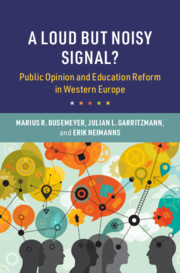Book contents
- A Loud but Noisy Signal?
- Cambridge Studies in the Comparative Politics of Education
- A Loud but Noisy Signal?
- Copyright page
- Contents
- Figures
- Tables
- Preface and Acknowledgments
- 1 Introduction
- 2 Theoretical Framework
- Part I Quantitative Evidence: Attitudes, Public Opinion, and Politics
- Part II Qualitative Evidence: The Role of Public Opinion in Education Reforms in Western Europe
- 9 Comparative Summary and Conclusions
- References
- Index
9 - Comparative Summary and Conclusions
Published online by Cambridge University Press: 14 September 2020
- A Loud but Noisy Signal?
- Cambridge Studies in the Comparative Politics of Education
- A Loud but Noisy Signal?
- Copyright page
- Contents
- Figures
- Tables
- Preface and Acknowledgments
- 1 Introduction
- 2 Theoretical Framework
- Part I Quantitative Evidence: Attitudes, Public Opinion, and Politics
- Part II Qualitative Evidence: The Role of Public Opinion in Education Reforms in Western Europe
- 9 Comparative Summary and Conclusions
- References
- Index
Summary
The concluding chapter summarizes the main findings from the case studies and the preceding quantitative analysis. Broadly speaking, we find strong support for the theoretical framework developed in Chapter 2. We also identify some patterns, i.e. school politics usually follow the logic of “loud but noisy politics.” In the other educational sectors (early childhood education and vocational education and higher education), it depends much more on the particular issue and country context whether an issue falls into the domains of quiet, loud, or loud but noisy politics. We also discuss several implications of our findings. For instance, we find that by and large, middle-class parents have a strong influence on the politics of education reform. Furthermore, even if they desire to influence public opinion in their preferred ways, political parties and interest groups have little success in actually achieving this. We close by inviting scholars to further explore the usability of our framework for other policy areas besides education.
- Type
- Chapter
- Information
- A Loud but Noisy Signal?Public Opinion and Education Reform in Western Europe, pp. 308 - 326Publisher: Cambridge University PressPrint publication year: 2020



